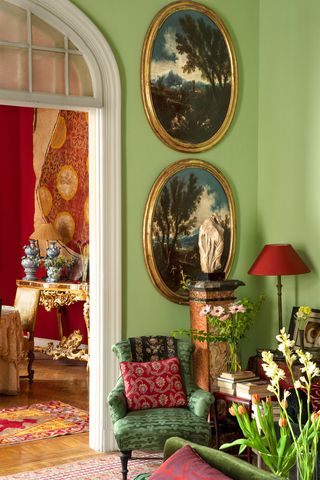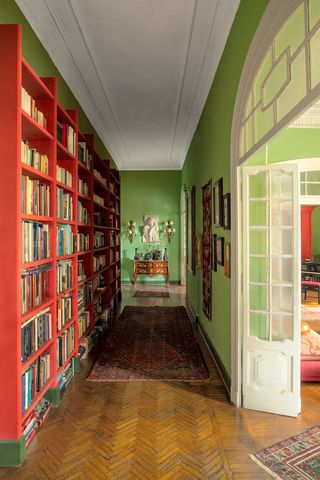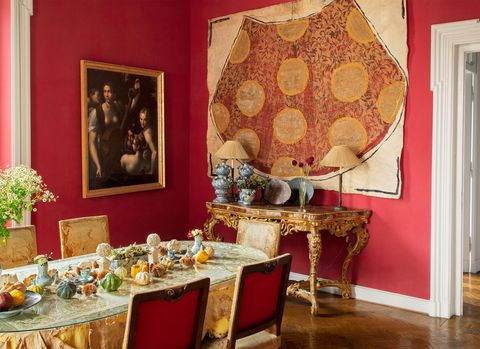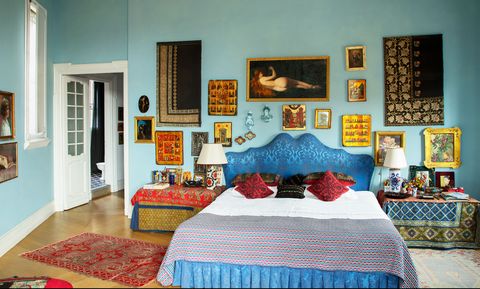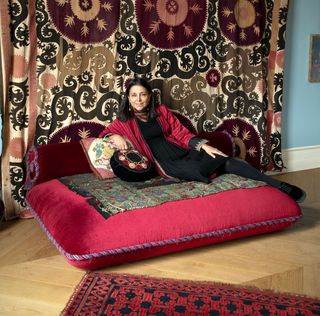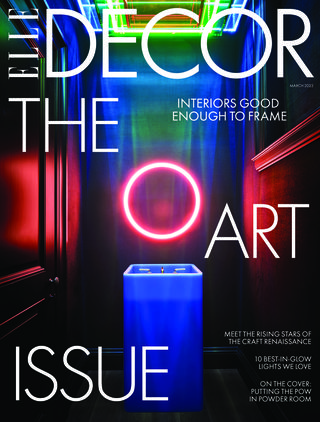An invitation to Carolina Vincenti’s Roman apartment offers a rare thrill: the serendipity of surprise. The art historian—together with her partner, Paolo Scotto di Castelbianco, a food and wine critic—is legendary for the highly original gatherings she stages in a home furnished with Old World splendor. For a recent dinner party, for instance, they re-created dishes from a 17th-century menu they had fished out of the dusty archives of a Baroque palazzo. Other evenings might feature music and cuisine inspired by her Romanian ancestry, or readings of experimental poems paired with piano sonatas performed by Scotto di Castelbianco on his Steinway.
All of this entertaining takes place amid rooms in pistachio and red that are filled to their soaring ceilings with the couple’s collections. Walls are hung with Old Masters and futurist art, tables are stacked with Italian maiolica, and endless bookshelves are filled with tomes. “Addicts of minimalism should steer clear of my home!” Vincenti warns with a laugh.
Formerly the headquarters of a political party, the sunlit apartment is on the fourth floor of an early-20th-century building a stone’s throw from the Baroque splendors of the Piazza Navona and the bustling market square of the Campo de’ Fiori. When the couple first saw it in 2015, they were flabbergasted by the abundance of space. At last, they had found a home large enough for their beloved things.
Collecting has often been associated with a desire to create a world that pays homage to an idealized past. Like many expatriates, Vincenti, who was born in Bucharest and raised in Beirut, follows in this tradition. She fled Beirut with her mother in 1975, soon after the onset of the Lebanese civil war. They arrived in Rome and filled their new home with all the possessions they had managed to salvage from their previous life. “The apartment had the patina one would expect from a 16th-century palace,” she recalls of an adolescence spent surrounded by history. “But it was a time warp: Even television was banned.”
Reading became Vincenti’s pastime. Not surprisingly her first collection, which she started when she was 15, was an array of illustrated children’s books. She went on to study art history at university and obtained a doctorate degree in 18th-century sculpture. Since then she has published several books on the art and architecture of her adopted city, including her most recent title, Soul of Rome: A Guide to 30 Exceptional Experiences. Fluent in five languages, she also organizes made-to-measure walking tours of Rome and the surrounding area.
The couple’s collection of Old Masters—mostly 17th- and 18th-century Italian oil paintings—inspired their apartment’s intense color palette. Historically, she explains, “these paintings were conceived to be hung on pigmented walls.” So, in the entrance, a long corridor filled with bookshelves, she replicated the strawberry red of old phone booths in England. For the living room she opted for a soft Rajasthan green.
The adjacent dining room, also painted red, bears testimony to her obsession for fabric. The table, a large oval that seats up to 10 people, is covered with a fine 18th-century embroidered silk from the Italian port of Genoa, Scotto di Castelbianco’s hometown. The dining chairs are upholstered with Aubusson fabric. Dominating the room is a magnificent tapestry by the Italian artist and textile expert Isabella Ducrot. The deep red envelope of the space also perfectly offsets Scotto di Castelbianco’s collection of 18th-century blue-and-white Genoese porcelain.
Elsewhere in the apartment, centuries-old silks from the historic San Leucio factory in southern Italy are mixed with colorful contemporary patterns by the Milanese designer Idarica Gazzoni. Meanwhile, Vincenti’s vast collection of antique fabrics—textiles from the Balkans, ancient weaves from her travels along the historic Silk Road route—are draped on furniture and displayed alongside Renaissance portraits on the walls.
Sitting on a plush 1940s sofa that was once in her grandmother’s home in Bucharest and has since been re-covered in green Italian silk, Vincenti muses on the eclecticism that makes her home feel timeless. Everywhere, there are vases filled with fresh roses and branches from the couple’s cottage in Umbria.
While we chat, she is suddenly reminded of an idea the writer Aldous Huxley proposed: that there is a spirituality inherent in the material world. “That idea struck a chord deep inside me,” Vincenti says. “It became my mantra.” One that allows her to indulge her collector’s bug without the tiniest pang of guilt.
This story originally appeared in the March 2022 issue of ELLE DECOR. SUBSCRIBE
This content is created and maintained by a third party, and imported onto this page to help users provide their email addresses. You may be able to find more information about this and similar content at piano.io
